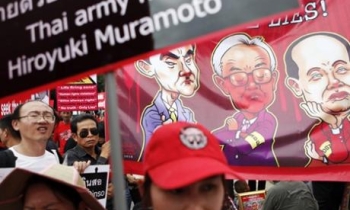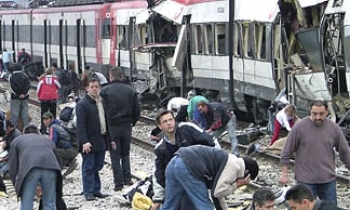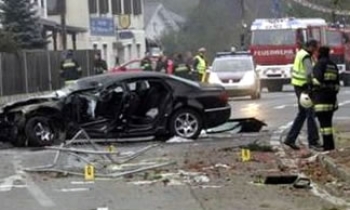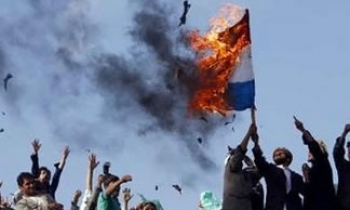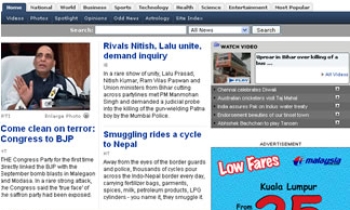PARIS - Political cartoonists in the United States, the Middle East and elsewhere fear their profession risks becoming a victim of the worldwide furor provoked by Danish caricatures of the Prophet Muhammad.
More than angry Muslims, some artists see a threat in their own paymasters - who they suspect may start trying to tame controversial art.
"These are not good times for political cartoonists. And I think this controversy makes it worse, because editors are timid and they see their cartoonists as bomb-throwers who need to be reined in," said MSNBC.com cartoonist Daryl Cagle in a telephone interview.
His syndicate, Cagle Cartoons, Inc. distributes some 50 cartoonists' work to newspapers in the United States, Canada and Latin America.
European cartoonists have published their own Muhammad sketches in solidarity with the Danes. American artists have been doing the same - but a few say they have encountered difficulty in getting sketches printed.
Brian Fairrington says The New Republic magazine asked him for a cover to illustrate an issue following up on the Danish drawings but shied away from his sketch of a turbaned man with a sword fighting another clutching a bible, a drawing he says was originally their idea.
The New Republic's assistant managing editor, Adam B. Kushner, said the reasons for spiking the cartoon "had nothing to do with the 'reaction' we thought it might generate."
"The problem was that his sketches, despite our repeated urging, failed to represent the four-story cover package that we ran in that issue," Kushner said in an e-mail to The Associated Press. "This was a purely aesthetic decision."
Cartoonists have been active participants in the worldwide debate sparked by the Muhammad sketches, which has largely centered on broad questions about the precarious balance between free expression and respecting religious sensitivities.
The Muhammad caricatures, first published in a Danish newspaper in September and since reprinted by other mostly Western media - sometimes in the name of free speech - were artistically unremarkable but challenging: One showed Islam's prophet with a bomb-shaped turban.
Muslim anger over the cartoons, stoked, some allege, by Iran and others, finally erupted this year into violent protests and attacks on Danish and other Western embassies in several Muslim countries. Dozens have been killed in the protests.
Cartoonists have poked fun at the protests and expressions of Muslim outrage. Some challenge the notion that the Danish sketches warranted such a fuss. Others suggest that Muslims are being hypocritical, getting steamed over cartoons but not over terrorism.
"Don't these people have a Goddamn sense of humor?" an angel asks of Jesus in a cartoon by Vince O'Farrell in Australia, one of dozens from around the world collected on Cagle's http://www.cagle.com.
Cartoonists have also looked inward, with drawings that portray a profession under siege, with suicide bombers or men with swords looming menacingly over artists' shoulders.
Mark Cohen in New Jersey drew a cartoonist at his draft board, deep in thought about the Muhammad issue. Then, in the last two frames, a hooded terrorist hacks off his head and bears it away, bleeding.
Rainer Hachfeld in Germany also drew an artist being beheaded. French cartoonist Stephane Peray, based in Bangkok, Thailand, drew severed hands strung from a soccer goal post, still clutching pens and dripping blood.
Iranian cartoonist Nikahang Kowsar, who was briefly jailed in 2000 for drawing an Iranian cleric as a crocodile, said he fears for colleagues' freedom in the Muslim world. The art was a 19th-century European export to the Middle East and tolerance for cartoons is lower there than in the West, Kowsar said.
In the wake of the Danish sketches, cartoonists "will be under the microscopes of the authorities and powerful Islamic leaders," he said in a telephone interview from Canada, where he now lives.
"To make sure cartoonists will be acting as good fellows, they will ask them to attack Israel, the Holocaust, and make sure they will be the good guys the governments want them to be. This is bad for the art."
One of Iran's top newspapers, Hamshahri, has already launched a contest to solicit cartoons about the Holocaust, in what it says is a test of the Western world's readiness to print sketches about the Nazi slaughter of 6 million Jews in World War II.
An Israeli cartoonist, Amitai Sandarovich, has responded to the Iranian effort with an unconventional contest of his own: He's asking Jewish artists to draw anti-Semitic cartoons themselves.
Qatar-based cartoonist Shujaat Ali, whose animated cartoons run on http://www.aljazeera.net, says he would like to see a code of ethics for cartoonists. "We must keep ourselves away from religious issues," he said.
He, too, fears a backlash from the Danish cartoon controversy.
"People will start thinking that these things are making trouble for the organization or for the newspaper, so maybe many people will lose their jobs," he said by telephone. "It is unfair for the whole cartoonist community because not all of us try or intend to attack any religion."
Cartoonists' perceptions that their freedoms may be threatened come on top of financial pressures, especially for artists in the United States.
American newspapers now employ fewer than 90 full-time cartoonists, down from a peak of nearly 200 in the 1980s, according to a 2004 report by Harvard University's Nieman Foundation for Journalism.
"Political cartooning is a profession that may be dying along with newspapers," said Cagle.
Others say that, ultimately, the Muhammad crisis may actually boost cartooning by offering a powerful reminder of its ability to focus attention on issues.
"For a while, I'll bet, we'll be paid a bit more attention to," said Richard Crowson of The Wichita Eagle in an e-mail. "Will we be put on shorter leashes? I doubt it in the long run."
Associated Press Writer Paul Duke contributed to this report from Paris.


